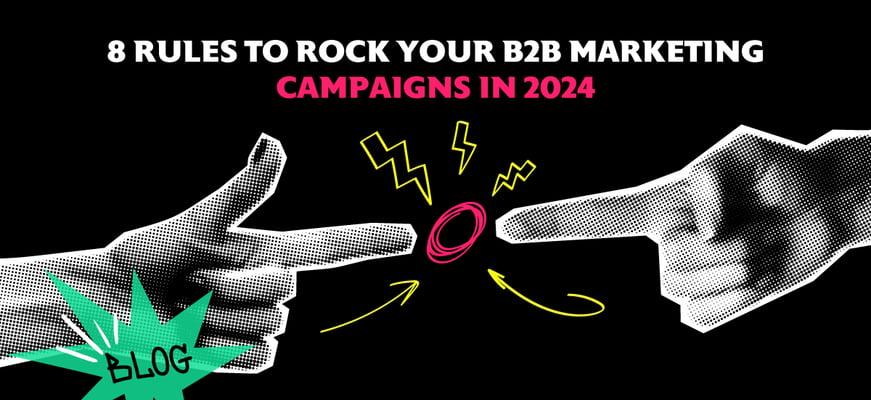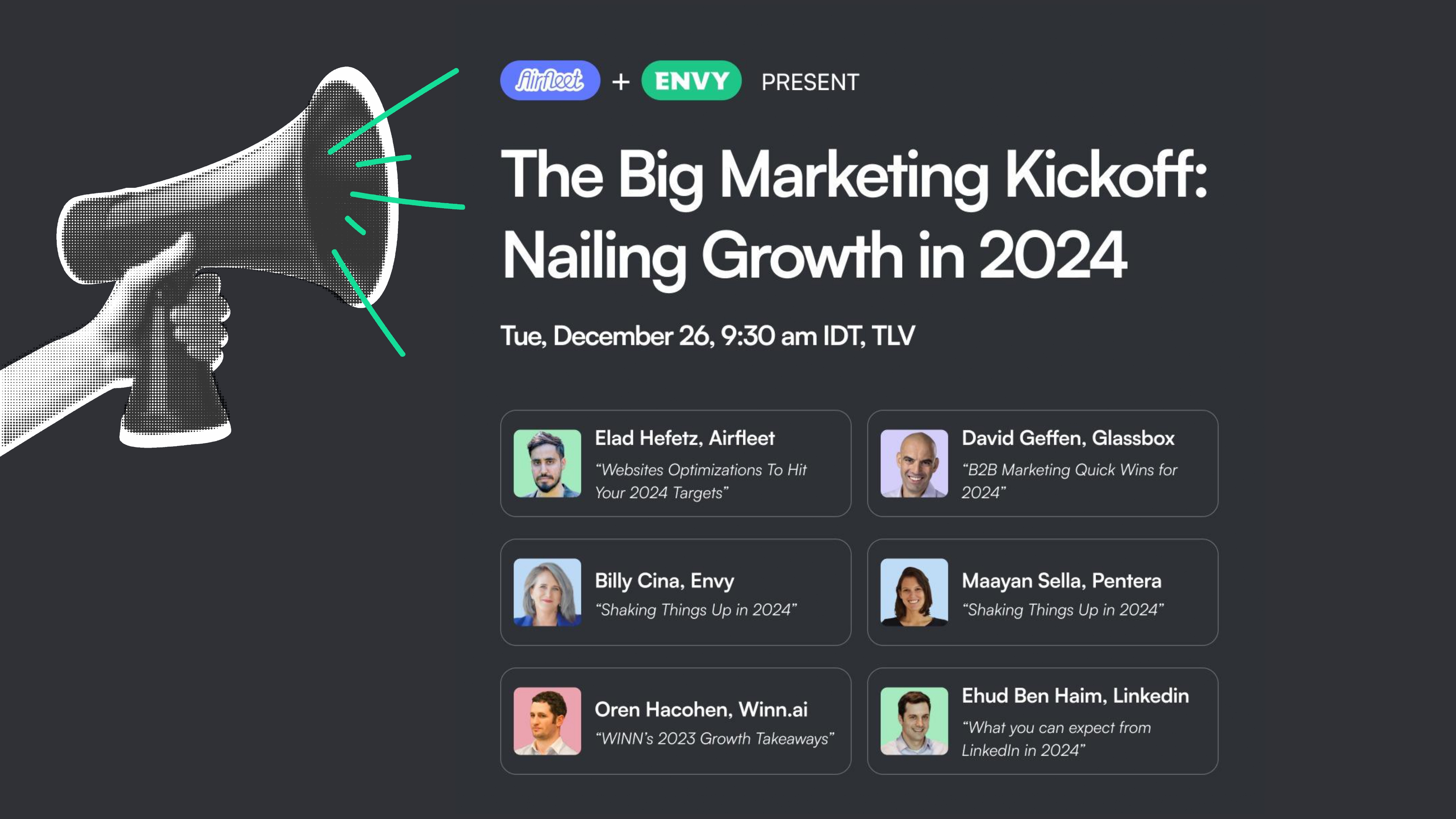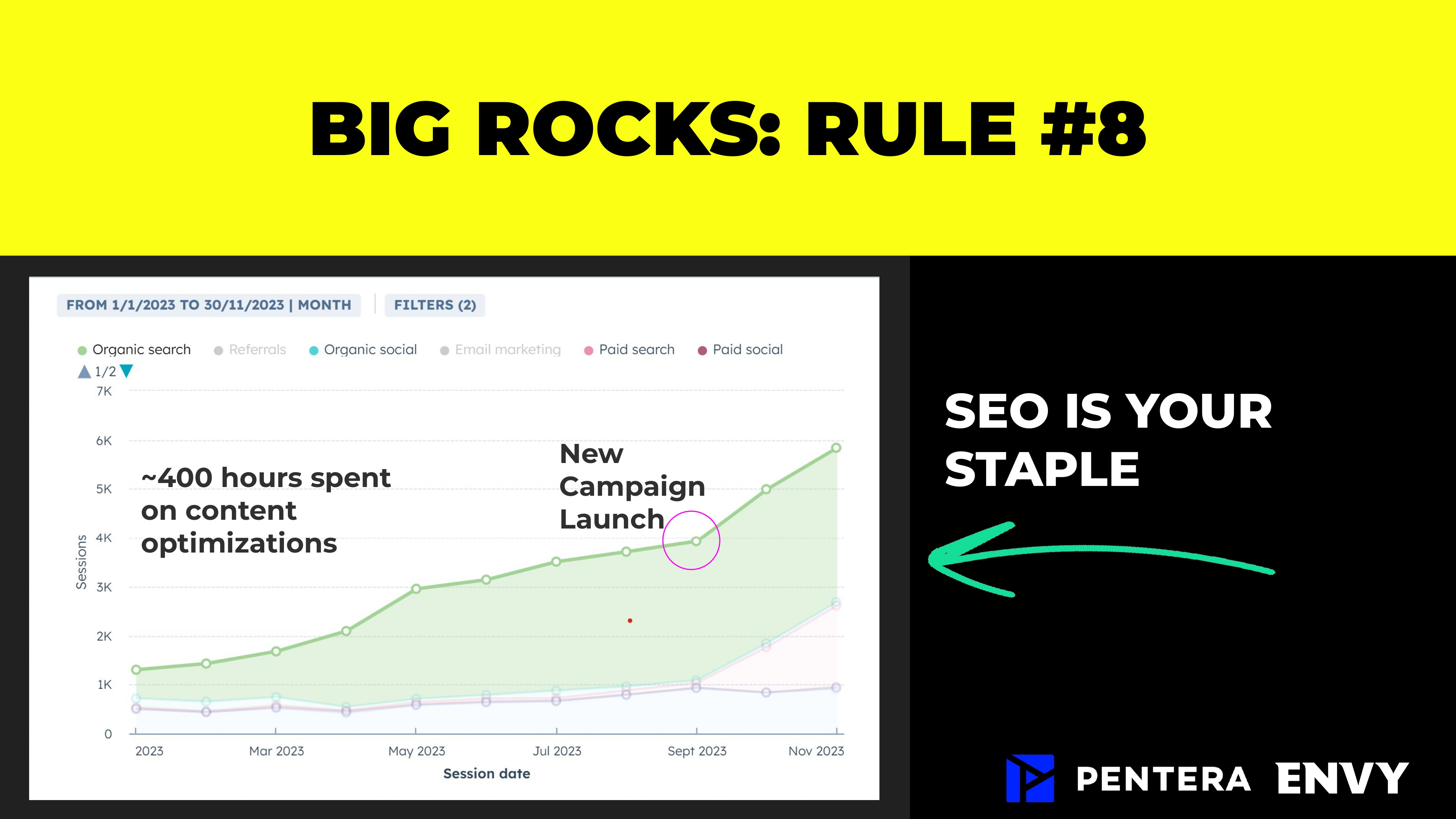
8 rules to rock your B2B marketing campaigns in 2024
At the very end of 2023, along with Airfleet we held The Big Marketing Kickoff, an event during which we’ve spoken about the highs and lows of the past year in the B2B marketing world, and shared our plans for growth in 2024 with an audience of no less than 150 brilliant B2B marketers.
Billy Cina of Envy and Maayan Sella from Pentera bantered over how to shake things up in 2024 to get your B2B marketing campaigns out there and do so successfully. And since so many of you have asked, below is a condensed version of what we said.

8 rules to rock your B2B marketing campaigns in 2024
So, back to the important stuff. What we’ll be focusing on can be split into three larger categories: polishing your campaigns, adjusting your measurements and taking care of your big rocks. Don’t worry, we’ll explain that last one later.
Rule #1 No content, no campaigns
The days when a single ebook and a couple of demo ads were enough to bring in qualifiable top of the funnel leads are long gone. You really need to have a wide variety of good quality content AND have it in good quantity. Various research shows that people need at least 8-12 touch points with your company before deciding on any sort of engagement, they need to see what you’re doing a couple of times (preferably on different platforms, but we’ll get to that next) to take the first step.
Below is an example of one of the campaigns we prepared for Check Point, see how many different types of content you can have for just one campaign? There’s blogs, there’s obviously social - both organic and paid - there’s videos, ebooks, webinars, podcasts, even infographics or whitepapers, all that can help you boost that campaign’s success.

The trickiest bit? Campaigns are a beast that need to be fed with tons of content constantly. Consistency is key, so do make sure to plan as much ahead of time as possible.
Rule #2 No distribution mix, no campaigns
Just like you need to have a wide variety of content, you should make sure you publish it across a wide variety of channels, as they all quite literally bounce off each other. Imagine someone sees your post on LinkedIn, but keeps on scrolling, next time they see your ad on GDN and since they recognize you, there’s a higher chance they’ll stop and click on it since they recognize you from somewhere else. Don’t spend all your budget on just one platform, but try evening it out instead. This will help you increase your brand’s visibility and maximize your reach.
Another thing is, you surely have a well defined buyer persona that you’re trying to attract, but focusing too strongly on decision makers only might work against you. Communities across all stages of the funnel are getting bigger and more influential as we speak, but they’re not necessarily on LinkedIn or won’t necessarily be attracted by your Google ads. Instead, they’re on Reddit, Twitter and similar forums and they might have a say when their team is choosing a new product or a new company to work with. Try dedicating some resources to organic reach and community building activities to work on brand awareness.
Rule #3 Frontloading your marketing budget
This one’s really simple. If you want to close as many deals as possible by the end of the year, don’t spread your marketing budget evenly across all months, but front load it instead. Invest heavily in the first half of the year to build awareness, nurture leads and establish strong relationships with potential clients earlier in the year to bear the fruits later. This will help you set foundations for a successful end-of-year sales push.
Important to mention, investing heavily in the first half of the year does not mean skipping Q3 or Q3 entirely. You want to still be active and visible, but not as much as in Q1 or Q2. For example, here’s how Pentera plans to distribute their budget:

Rule #4 Verticals are the way to go
We know many companies are hesitant when it comes to verticalization and perceive it as limiting, but focusing on just one or two verticals allows you to build heavily personalized content, and this in turn means higher rewards in terms of ROI. Before tailoring your campaign to specific industries and creating vertical-specific content, conduct a thorough research to determine which industry you want to focus on - this can be based on which industry gives you the shortest sales cycle, lowest churn, largest ASP, etc.
Key elements you can focus on in your verticalized campaigns are:
- Powerful datasheet and web page (of course),
- A webinar with an industry expert to attract leads,
- Case study with an recognized vertical leader,
- Content distribution mix to make sure you’re getting the most out of your campaign,
- Dedicated ads etc.
Rule #5 Define your buckets
It might be tricky to accurately measure ROI if you’re unsure where your leads are coming from, but such is a B2B marketer’s life nowadays. The Dark Funnel is here to stay for a while as is the non-linear buyer journey.
As a first step, define your buckets – sources which you’re investing in and you can attribute generated leads to. Make them broad in order to alleviate the never-ending challenge of finding the source. Here are buckets that Maayan uses in her role; pretty self explanatory and broad enough to provide the big picture of what’s working well in your marketing stack:

Everyone’s buckets will be different, but there are a few things that might make setting this up easier for you:
- Most marketing activities come from a joint effort, so it won’t necessarily make sense to keep a bucket for each channel separately;
- It’s always great to ask new leads where they came from directly or where they heard about you. This will help you attribute this lead to a proper bucket;
- Maayan uses a separate bucket for brand and there she includes all leads that can not be directly attributed to a specific activity. Or when folks state, “internet” as their source… Very unhelpful, agreed. But I believe everything we do in marketing touches our brand. Without a brand, you wouldn’t be able to succeed in any other parameter.
Rule #6 Pay attention to dark paid funnel
My friends, the dark funnel is real whether we like it or not. You can analyze all traffic sources as carefully as possible, track all direct and organic to get an understanding of how impactful your paid campaigns are, but if you’re not checking the data across multiple sources, you won’t be able to fully grasp the success of your campaign.
Have a look below at what happened when one of our clients heavily invested in a paid LinkedIn campaign in June, which was later stopped – the traffic dropped straight away on LinkedIn, but didn’t on Google and that’s the effect your campaign can have across different platforms. So when determining its success, don’t just check one dashboard where you’re advertising. Have a look at other platforms as well, and – most importantly – see how conversion rates directly on your website.

Rule #7 Define your big marketing rocks
And we’ve reached the mysterious big rocks! We all know how we get pulled in all the different directions in marketing – directions that effectively keep us away from our own goals. So think of these goals as your big marketing rocks, define what you want to stick to during the year ahead and share this across teams. The next time someone asks for your help, you’ll be able to say no if helping means putting your big rock aside, and shout YES out loud if helping means getting closer to achieving the goal faster together. For example, if your team’s big rock for this year is recruiting 20 new channel partners, and your colleague asks for help in setting up a channel partner portal, then you can go ahead and prioritize this as it’s getting you closer to your goal.
Rule #8 SEO is your staple
We know there’s more and more naysayers when it comes to SEO, but we believe it’s not dead just yet. Investing in good SEO practices is vital if you want to grow organically and reach your target audience effectively. This means optimizing your website, any content you produce and your overall online presence in order to rank higher and become more visible, helping people to find you.
Need proof? Have a look at the graph below. As many of you know, last year we changed our name from Marketing Envy to just Envy – and we’re not going to lie, our traffic took an immediate hit. But we’ve worked hard on optimizing our website and producing the right kind of content that we knew resonates with our audience until we started getting more and more visibility again. And this spike in October? That’s when we launched a new campaign on LinkedIn and Google, so yes, SEO is still delivering results if you use it right.

Conclusion
So here it is, just eight things that can help you boost your B2B marketing campaigns this year. And listen, you don’t need to jump to all eight and flip your marketing strategy on its head. Start gradually and see what works for you.
Sounds overwhelming? We’re here to help, so get in touch to see what we can do together for your brand.
Psst if you don’t want to miss our next event, make sure to follow us on LinkedIn.





